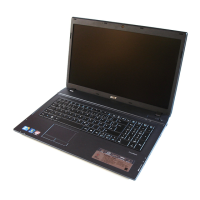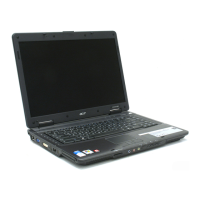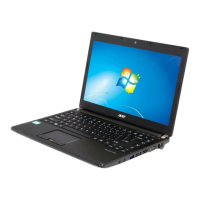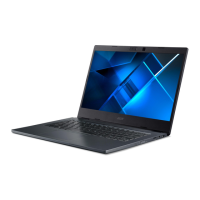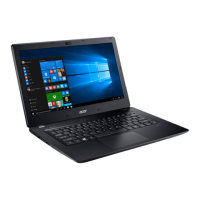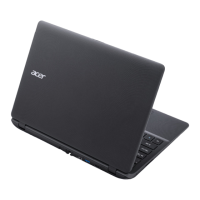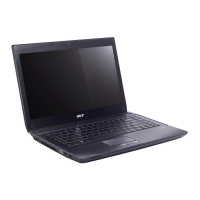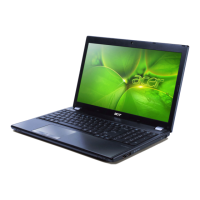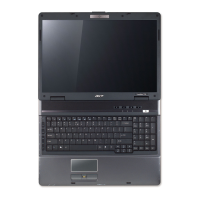
Do you have a question about the Acer TRAVELMATE 7730 and is the answer not in the manual?
| Tjunction | 100 °C |
|---|---|
| Processor cache | 2 MB |
| Processor cores | 2 |
| System bus rate | - GT/s |
| Processor family | Intel® Core™2 Duo |
| Processor socket | Socket 478 |
| Processor codename | Penryn |
| Processing Die size | 107 mm² |
| Processor frequency | 2.1 GHz |
| Processor cache type | L2 |
| Processor lithography | 45 nm |
| Processor manufacturer | Intel |
| Processor front side bus | - MHz |
| Processor operating modes | 32-bit, 64-bit |
| ECC supported by processor | No |
| Thermal Design Power (TDP) | 35 W |
| Number of Processing Die Transistors | 410 M |
| Motherboard chipset | Intel® GM45 Express |
| HDD speed | 5400 RPM |
| HDD interface | SATA |
| Card reader integrated | Yes |
| Total storage capacity | 320 GB |
| Compatible memory cards | MMC, MS PRO, SD, xD |
| Display diagonal | 17 \ |
| Display resolution | 1440 x 900 pixels |
| Native aspect ratio | 16:10 |
| Contrast ratio (typical) | 400:1 |
| Type | PC |
| Modem speed | 56 Kbit/s |
| Wireless technology | 802.11n |
| Graphics card family | AMD |
| Internal memory | 3 GB |
| Memory clock speed | 667 MHz |
| Internal memory type | DDR2-SDRAM |
| Maximum internal memory | 4 GB |
| Maximum resolution | 2048 x 1536 pixels |
| Discrete graphics card model | AMD Radeon HD 3470 |
| Maximum graphics card memory | 1.024 GB |
| Discrete graphics card memory | 0.512 GB |
| Video capturing speed | 30 fps |
| Front camera resolution (numeric) | 0.3 MP |
| Networking type | Gigabit Ethernet |
| Networking features | 10/100/1000 MBit/s |
| Operating system installed | Windows 7 Professional |
| Optional operating system supplied | Windows XP Professional |
| Battery life (max) | 2.5 h |
| Number of battery cells | 6 |
| Charging port type | DC-in jack |
| Serial ports quantity | 0 |
| USB 2.0 ports quantity | 4 |
| CardBus PCMCIA slot type | Type II |
| Cable lock slot type | Kensington |
| Password protection type | BIOS |
| Pointing device | Touchpad |
| Processor ARK ID | 42841 |
| Depth | 286 mm |
|---|---|
| Width | 396 mm |
| Height | 35.2 mm |
| Weight | 3400 g |
Details platform, system memory, and display specifications for the notebook.
Visual representation of the notebook's internal architecture and component connections.
Identifies key external notebook components and their functions.
Explains keyboard layout, lock keys, and Windows-specific key functions.
Lists detailed specifications for CPU, controllers, BIOS, memory, and storage.
Guide to configuring system settings through the BIOS interface.
Instructions for updating the system's BIOS firmware.
Procedures for removing HDD or Supervisor password locks.
Essential safety guidelines to prevent damage from electrostatic discharge during maintenance.
Lists necessary tools for disassembling and repairing the notebook.
Detailed instructions for installing or replacing RAM modules.
Instructions for removing and installing the main hard disk drive.
Step-by-step guide for replacing the entire keyboard assembly.
Detailed steps for removing and replacing the entire LCD panel assembly.
Detailed procedure for replacing the main system board.
Guide for removing and installing the CPU.
A guide to identifying and analyzing notebook issues.
Steps for testing specific hardware components like drives and input devices.
Steps to diagnose issues related to the battery and power adapter.
Information on interpreting BIOS POST error codes and messages.
A list of error codes, their messages, and recommended actions.
Identifies and locates connectors on the top side of the system board.
Identifies and locates connectors on the bottom side of the system board.
Instructions for clearing BIOS passwords and performing BIOS recovery.
Visual breakdown of the notebook's components for identification.
A detailed list of all field-replaceable units with part numbers.
Details specific model configurations, region, and part numbers.
Lists components tested for compatibility with Windows Vista.
Information on accessing Acer's online technical support resources.
